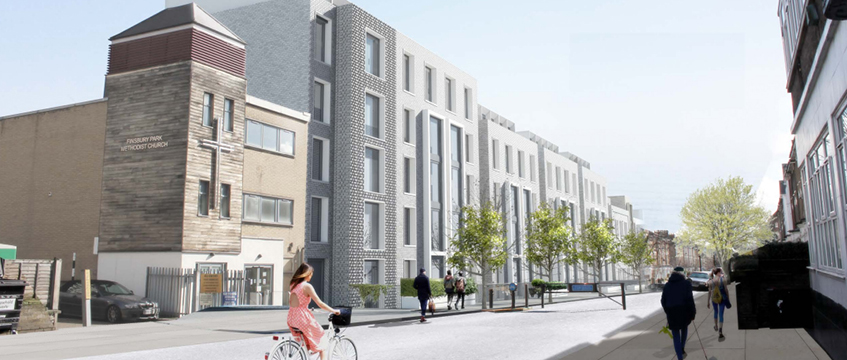Hackney’s first co-living scheme has been refused after a planning officer deemed its impact on heritage and affordable provision to be “unacceptable”.
Rainbow Properties’ 146-room project at 3-27 Wilberforce Road, N4, has been rejected by Hackney Council almost two years after plans were lodged.
The co-living scheme was refused by planning officers who exercised their delegated powers to block the scheme before it was put to the committee.
Planning officer Toyin Omodara said: “The project is considered unacceptable in terms of its design, its impact upon heritage assets, the standard of accommodation proposed, its failure to provide the maximum reasonable amount of affordable housing and its failure to mitigate for the proposed loss of trees from the site.”
Omodara said the development would therefore fail to comply with pertinent policies in Hackney’s Local Development Framework, the London Plan and the National Planning Policy Framework.
The report said that Hackney prioritises residential development (C3) over alternative forms of housing like co-living, as stated in the draft local plan, in the absence of co-living or PRS policy.
This means developers must demonstrate that standard residential units cannot be delivered in order to secure approval for co-living schemes.
Rainbow Properties is a London-based residential landlord founded in 1985 which lists a small number of flats for rent in central London and has no existing co-living opportunities. The company is majority owned by Shmuel Ziser, a former footballer from Israel who moved to East London to set up a textiles business and heads up property investment firm Ziser London.
Communal living plans
Rainbow had proposed demolition of the terraced housing and Central Park Hotel at 3-25 Wilberforce Road, to be replaced with a building of up to six storeys comprising “communal living accommodation” alongside 16 flats.
The 146 rooms were to range from 20-35 sq m, with 15 sq m of private living space and 5 sq m of en suite bathroom facilities. Of these, 36 rooms were described as “self-contained”, including kitchen facilities in the rooms.
Hackney said that the proposed space was adequate but argued that the scheme was not “high quality”, due to a lack of amenity space and poor light and ventilation on the ground floor.
In its viability assessment the developer said it would not be able to provide any affordable housing.
Rainbow had targeted the scheme at “graduates and young professionals”. While Hackney council claims there is demand for co-living in the borough and a lack of housing for young professionals, the report argued that Rainbow had failed to show this particular cohort is “uniquely underserved by the housing market to the degree that would warrant restricting occupation to this group alone”.
The scheme was opposed by campaigning group Save Wilberforce Road, which fought to save the 1870s Victorian housing, which had been identified as non-designated heritage assets by the council. Hackney Council reported no other external objection from any organisations.
To send feedback, e-mail emma.rosser@egi.co.uk or tweet @EmmaARosser or @estatesgazette











